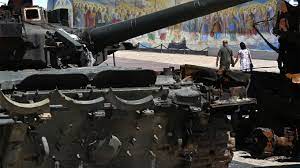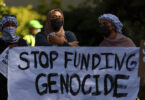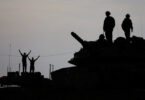Robert Jenkins
More than a year into the continuing, cruel conflict over Ukraine, there is no end in sight. There may also be a real risk of it escalating into potentially wider, even nuclear war. A military defeat of either Russia or Ukraine, or a stalemate ceasefire, may only perpetuate long-term conflict with Russia and prevent any lasting, real settlement.
The long-term negative consequences of this may be global in impact, including for international geopolitical stability in the 21st century. Further deeply alarming is the striking absence of any engagement between Russia and the West on a solution to the Ukraine conflict.
The path to peace may lie in effective security guarantees for both Russia and Ukraine through an overarching European Security Treaty. Only this may create the conditions for Russia and Ukraine to achieve a negotiated settlement to their conflict. Any solution must guarantee Ukraine’s independent sovereignty and territorial integrity. It must also address Russia’s legitimate security concerns.
For this, a collective Western initiative is necessary. The circumstances of the conflict make it hard to see how either Russia or Ukraine could initiate proposals to meet these essential requirements. A settlement between them will also need to address both the causes and consequences of Russia’s unilateral military action against Ukraine.
Central to the causes of the conflict has been the expansion of NATO after 1990. The conclusion may be reached that major mistakes were made in mismanaging international relations following the Cold War. Freed from the repressive domination of the Soviet Union, the countries of central and eastern Europe readily sought NATO accession. Yet this was not a proper solution to their security requirements. NATO’s sole purpose is to act collectively militarily as a defense alliance against attack on any member. A product of the Cold War, NATO has not constituted an effective overarching institutional security architecture, something that has been fundamentally lacking, in effect, ever since 1945. Following the Cold War and the collapse of the former Soviet Union, the West and NATO did engage proactively with Russia, creating an international security architecture. The 1990 Treaty of Paris, effectively ending the Cold War, established the Organization for Security and Cooperation in Europe. This was followed by the creation of NATO’s Partnership for Peace in 1994, with Russia a founding member. The ensuing 1997 NATO-Russia Founding Act aimed to “build together a lasting and inclusive peace in the Euro-Atlantic area on the principles of democracy and cooperative security.” It led to the establishment in 2002 of the NATO-Russia Council, as an institutional organizational framework for their coordinated cooperation – including in peacekeeping, arms control and theatre missile defense, “based on the principles of human rights and civil liberties, refraining from the threat or use of force against each other or any other state.”
Nevertheless, the parallel and continued enlargement of NATO from the 1990s significantly negated this, as it extended to embrace most eastern European countries and the Baltic states. From Russia’s perspective, it is readily understandable how NATO’s continuing eastward expansion was viewed as a threat, with the location of nuclear missiles in both Poland and Romania. Its enlargement enabled military, including missile, presence at Russia’s very borders, at only some 150 kilometers from St. Petersburg. Indeed, any Russian government could be regarded as irresponsible in not considering this as a potential threat.
On the road to Russia’s eventual military action over Ukraine, a key landmark was NATO’s 2008 Bucharest Declaration, stating that Ukraine and Georgia “will become members of NATO.” This was viewed by Russia as highly provocative.
With Ukraine’s increasingly West-facing political gravitation, NATO’s enlargement only served to heighten the Russian government’s alarm about this and their waning influence over Ukraine. Its 2004-2005 “Orange Revolution” raised the specter of Ukraine’s possible future accession to both the European Union and NATO.
For the Russian government, and possibly many Russians, this was highly emotionally charged. It clashed with a deep sense of close ethnic and personal as well as strategic economic and historical connections between Russia and Ukraine. With nearly one-third of Ukraine’s population native Russian-speaking, eastern Ukraine has a large Russian majority, particularly in the industrial Donbas region, and even more in Crimea, historically part of Russia until 1954. The Ukrainian government’s political de-russification action after 2004, in particular the de facto prohibition of education in Russian, was unnecessarily provocative. Faced with a loss of influence over Ukraine, its “near abroad,” Russia’s government has since sought to destabilize its neighbor, but with counterproductive consequences. Russia’s leadership viewed Ukraine’s 2013-2014 Maidan revolution, and the subsequent removal of unpopular pro-Russian President Yanukovich as unconstitutional, engineered by Western interference. Its ensuing annexation of Crimea in 2014 only served to reinforce Ukrainian nationalism and desire for independence, seriously damaging Moscow’s relations with both Ukraine and the West.
In its eventual 2022 military action over Ukraine, the Kremlin’s narrative about its rationale and objectives has been both changing and inconsistent. Starting as the de-militarization and de-Nazification of Ukraine, it has become an existential hybrid war against NATO and the West, seeking Russia’s dismemberment and destruction. In this supposed struggle for the defeat of a US-dominated unipolar world and its replacement by a new multipolar world order, misinformation and propaganda provide no basis for any settlement or peace. A threefold strategy for peace is proposed, envisaging a dual-track approach: The West needs to affirm with total clarity its sustained support for Ukraine. At the same time, it would put forward a solution for a new comprehensive European security architecture. Guaranteeing the territorial integrity of all, including that of Ukraine and its sovereignty as an independent state, would enable no NATO expansion, meeting Russia’s long-standing stated concerns about this. Such proposals would, in turn, create the conditions and context to make possible a settlement of the conflict between Russia and Ukraine.
Firstly, a European Security Treaty would be its foundation, with Russia a full participant in its creation, and NATO and Ukraine both fully integrated into this process. The existing Organization for Security and Cooperation in Europe could provide the institutional infrastructure for this. Long proposed by both the Soviet Union and Russia, a European Security Treaty would enshrine and provide comprehensive guarantees for the self-determination, sovereignty and territorial integrity of all member states. It would further provide guarantees and undertakings to protect all against foreign interference in their internal affairs, including in cybersecurity, with an international institutional infrastructure for ensuring treaty compliance and governance.
Secondly, a proposed European Security Treaty should facilitate Russia and Ukraine agreeing on a resolution to their conflict – and would be conditional on this. Indeed, all parties, including Russia, have a humanitarian and moral responsibility to permanently end the fighting. A territorial settlement over Ukraine may need to contain compromise, including on the political status of Crimea and the Donbas. A political settlement could provide constitutional arrangements for a devolved government and protection of the rights of all Ukraine’s citizens, including its significant native-Russian-speaking minority. With the devasting destruction to Ukraine caused by Russia’s unilateral military action, a settlement could also be expected to require a major financial contribution from Moscow toward Ukraine’s reconstruction. The agreement would also be necessary for an international investigation of all war crimes. Such necessary compromises may be hard to conceive but could be made possible, and only so, in the context of a wider settlement with comprehensive security guarantees.
Thirdly, a resolution of the Ukraine conflict on this basis would provide the basis for international legal undertakings on no future NATO expansion. The Ukraine conflict may only have driven Finland and Sweden along with Georgia and Ukraine to seek NATO membership. The longer the conflict continues, the more difficult it may prove to reverse this. However, the envisaged solution would enable its reversal or suspension. They could legally commit to this and not renew their NATO accession applications, on condition of full compliance with a European Security Treaty. NATO would similarly commit to no future enlargement, in the absence of a country application for this, and without contradiction to its founding treaty Open Door provisions permitting additional country accession. Such commitments on no NATO enlargement would be conditional on full compliance with a European Security Treaty. Of ultimate importance, over the long-term, this would further create the basis for gradual, progressive demilitarization in eastern Europe by all its signatory states, including Russia, together with NATO legal undertakings on this. The consequence of Russia’s Ukraine unilateral aggressive military action of course means that this would take time, perhaps a generation or more, to accomplish.
Could Russia respond positively to such a Western initiative? By clearly addressing Russia’s legitimate security requirements, the proposed strategy for peace could prove a catalyst or contributor agent of change within Russia. The ruinous consequences of Russia’s unilateral military action over Ukraine are self-evident. For Russia, these have been the exact opposite of its stated objectives. It has only reinforced Ukraine’s national self-identity, including among its large native Russian-speaking population. It has strengthened NATO’s cohesion and unity, with long-standing neutral Finland and Sweden, as well as Ukraine, seeking to join it. It has also weakened Russia internally, with the negative reaction to its Ukraine military action not confined to the non-Russian region of the Caucasus. It has brought about Russia’s international economic and political isolation.
The proposed strategy for peace would present a crucial challenge and choice for Russia. It would require Russia to recognize Ukraine’s right to exist as an independent state and determine its own future. This is a path that Ukraine incontrovertibly chose in August 1991, by an overwhelming 92% majority, with over 84% of its electorate voting, in a clearly democratic referendum.
In the disinformation war central to the conflict over Ukraine, the Russian narrative that NATO itself did not respect this principle in the Balkan conflict over Kosovo in the 1990s characterizes this wrongly. In reality, it was a necessary international intervention to prevent a potential civil war or genocide in the political vacuum following the break-up of Yugoslavia. A settlement of Ukraine’s conflict, within the wider context of a European Security Treaty, addressing Russia’s legitimate security requirements, would be overwhelmingly and obviously in Russia’s real and strategic national interests. It would represent a solution that Russia should feel compelled to consider. It would make possible permanent peace in Europe and its eventual progressive de-militarization. It would address its stated concerns that NATO’s real agenda and that of the US in particular is to weaken Russia and seek US dominance in a unipolar world. Rather it would make possible a future for Russia in which it is not isolated, with a leading position in a multipolar world, and of crucial importance to the 21st century geopolitically for the whole world. For Russia, this should be a compelling prize. Whether it would seize this, may turn, as much as anything, on Russia’s internal politics, and what its people may determine to be in Russia’s best and real interests.
The Moscow Times







